To Index Home Page
To View The Images:
Click
IMAGES ONLY
Then use your mouse
with the slider on the right of this frame
to view the 80+ images.
And See All The Images:
Click
FULL TUTORIAL

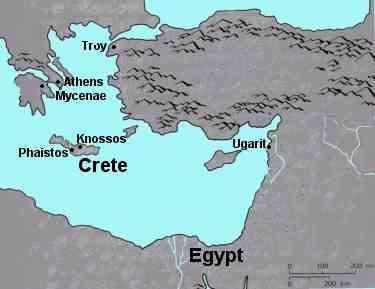
Click for Map
Tutorial No.5. - Image 001
Map of the Eastern Mediterranean Area

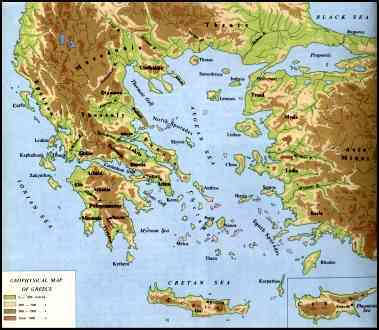
Click for Detail
Tutorial No.5. - Image 001a
Map of the Aegean Region

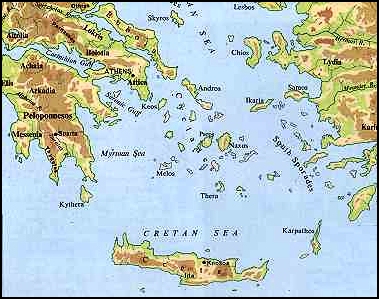
Click for Map of
Tutorial No.5. - Image 001b
Detail of Aegean Region

| AEGEAN BRONZE AGE CIVILIZATIONS | ||||
| PERIODS | MAINLAND GREECE | CYCLADES | CRETE | |
| LATE BRONZE AGE 1600-1100BC |
CRETO-MYCENAEAN | CRETO-MYCENAEAN | ||
| NEW-PALACE MINOAN 1700-1450BC |
||||
| MIDDLE BRONZE AGE 1900-1600BC |
MIDDLE HELLADIC |
MIDDLE CYCLADIC |
||
| OLD-PALACE MINOAN 1900-1700BC |
||||
| EARLY BRONZE AGE 2800-19OOBC |
EARLY HELLADIC |
EARLY CYCLADIC |
PRE-PALACE MINOAN |
|
| NEOLITHIC AGE 7000-2800BC |
PRE-BRONZE AGE CERAMICS 6000-2800BC |
|||
AEGEAN BRONZE AGE CIVILIZATIONS

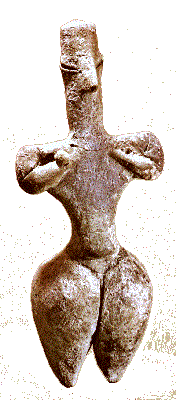
Tutorial No.5. - Image 003
New Stone Age early clay figurine, Nea Nikomedeia, Thessaly, Greece 6000-5500BC

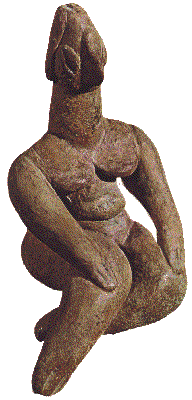
Tutorial No.5. - Image 004
New Stone Age clay figurine, Pharsala, Thessaly, Greece 5000-4000BC

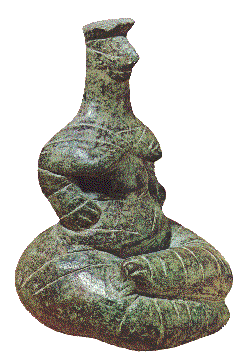
Tutorial No.5. - Image 005
Neolithic Cretan clay figurine. Similar cross-legged figurines have been found at Kato Hierapetra, in Eastern Crete c.4500-3500BC

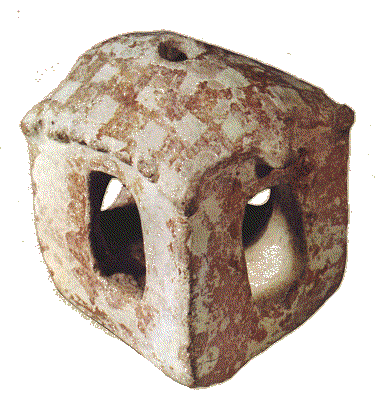
Tutorial No.5. - Image 006
New Stone Age clay model of a house. Sesklo,Thessaly, Greece c.5000BC

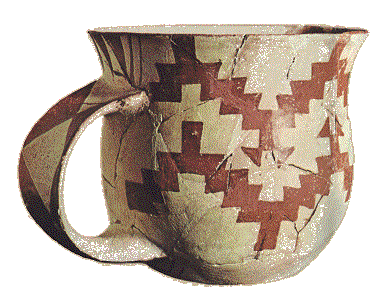
Tutorial No.5. - Image 007
New Stone Age red patterned clay cup c.5000-4000BC. Sophades,Thessily,Greece

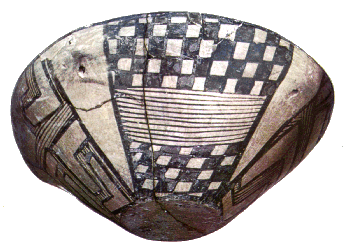
Tutorial No.5. - Image 008
Late Neolithic bowl painted in dark colour on a lighter slip. c 2800BC Dimini, Thessaly, Greece

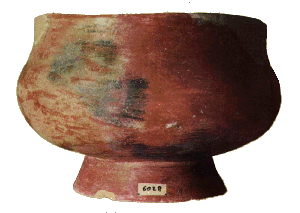
Tutorial No.5. - Image 009
Late Neolithic polished red bowl Sesklo,Thessaly,Greece ca.3000BC.

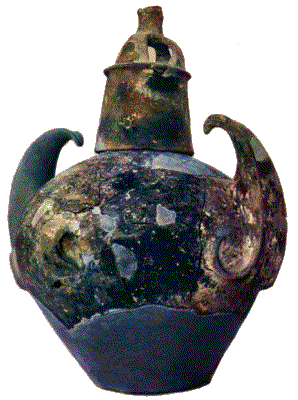
Tutorial No.5. - Image 010
Amphora with crowned lid and " arms",Poliochni,W.Anotolia. ca.2200BC parallels with copper vessels discovered in Troy II site.


Tutorial No.5. - Image 011
Cycladic islands of the Aegean produced these very characteristic idols during the latter half of the 3rd millennium BC.

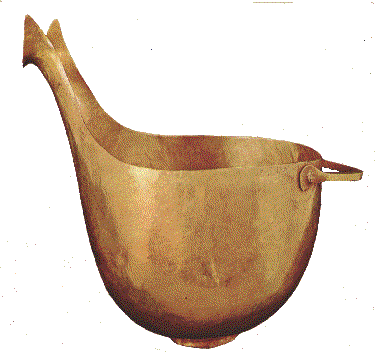
Tutorial No.5. - Image 012
An Early Helladic vessel in gold illustrates the origin of many un-pottery shapes in clay. Copies of metal objects. ca.2800-1900BC.

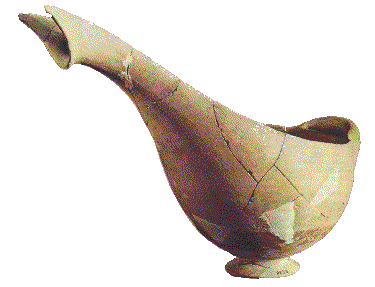
Tutorial No.5. - Image 013
Beak-spouted "sauce-boat" covered with "Urfinis" a primitive thin slip glaze. Raphina, Attica, Greece. Early Helladic II 2800-1900BC

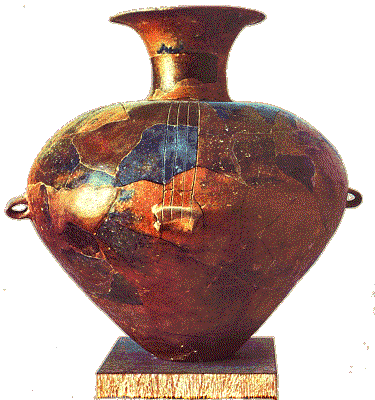
Tutorial No.5. - Image 014
An Early Helladic amphora covered with the primitive slip glaze.ca.2200-2000BC Orchomenos, Boetia, Greece.

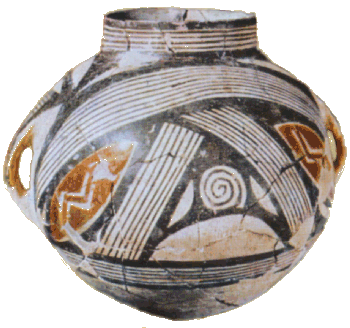
Tutorial No.5. - Image 015
Late Neolithic clay amphora decorated with spirals, other motifs and linear banding in dark brown and red on a cream coloured slip. ca.2800BC. Thessaly, Greece.

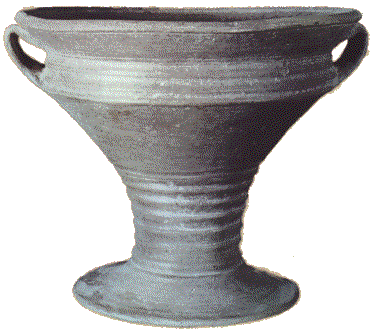
Tutorial No.5. - Image 016
Middle Helladic pottery - from Eastern Greece mainland. Minyan ware, grey thrown pottery reminiscent of metalworking 1900-1600BC.

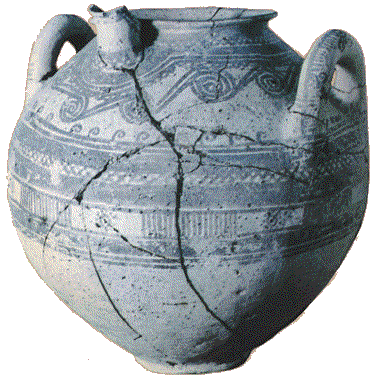
Tutorial No.5. - Image 017
late Middle Helladic pottery - found in a grave at Mycenae. Matt- painted with characteristic spirals and geometric linear patterns 1900-1600BC.

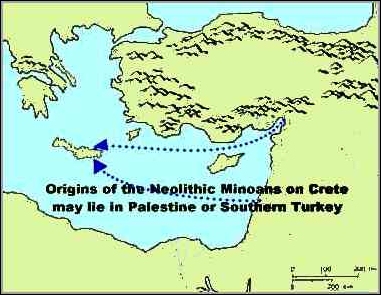
Tutorial No.5. - Image 018
Map showing the possible origins of the Minoans on Crete - Palestine or Sw Turkey

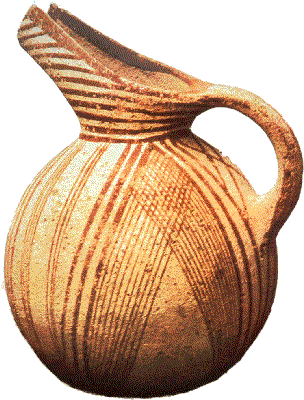
Tutorial No.5. - Image 019
A beak-spouted jug from southern Crete with a sophisticated linear decoration in a dark slip-glaze. Early Minoan I 2600-2300BC

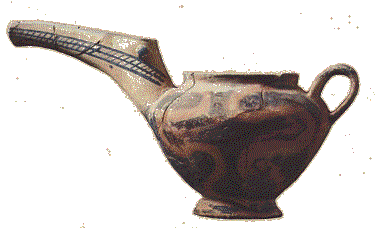
Tutorial No.5. - Image 020
Another beak-spouted vessel covered with dark slip-glaze painting in a mottled style.Pre-Palace Period 2300-2000BC.

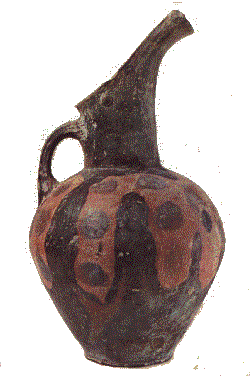
Tutorial No.5. - Image 021
Another beak-spouted jug from Crete. The bird-like shape is even more evident here. Brushed or poured slip glazes are used to form a mottled decoration. Pre-Palace Period 2300-2000BC.

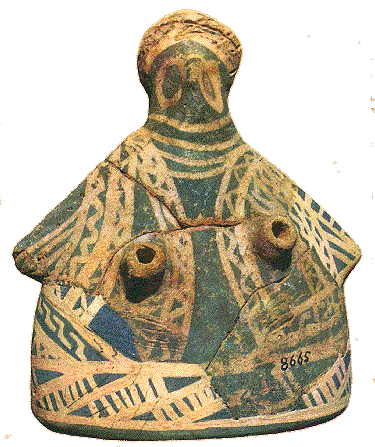
Tutorial No.5. - Image 022
A ritualistic clay rhyton in the form of a bust of the mother goddess squeezing the life-giving milk from her breasts. Painted with a white slip-glaze on top of a bright bluegreen. Pre-Palace Period 2100-1900BC.

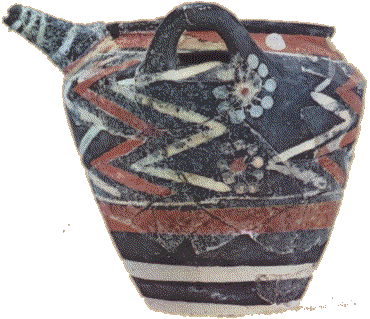
Tutorial No.5. - Image 023
A bridge-spouted vessel in a new advanced technique developed out of frit paste inlays - see my previous tutorial. The range of colours used has increased to included blues. An example of early Kamares style of central Crete in the Pre Palace Period. c.2000-1900BC.

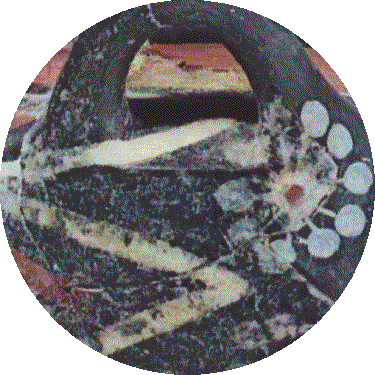
Tutorial No.5. - Image 023a
Detail or decoration.

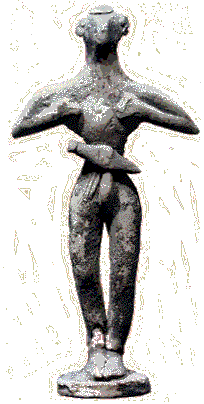
Tutorial No.5. - Image 024
Clay votive figure of a worshipper with a dagger. From a sanctuary in Eastern Crete. End of the PrePalace Period or beginning of the Old Palace Period. c.20th century BC.

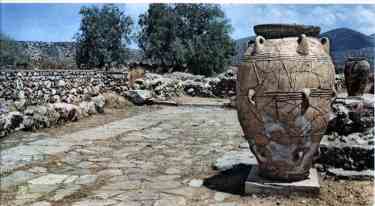
Tutorial No.5. - Image 025
Around 1900 BC the Minoans began to build Palaces on Crete.This is a view of of a couryard in a ruined remains of the Palace at Malia. On the right is a huge Old Palace Period storage jar or pithos decorated with successive rows of handles and bands that look like rope 1900-1700BC.

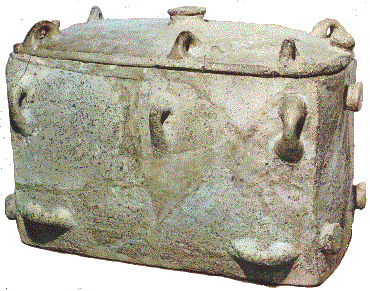
Tutorial No.5. - Image 026
Certain changes look place in the Old Palace Period: huge mass burial tombs were replaced by individual burials in pithoi or clay sargophagi. This one was found at Vorou, Megara, Crete 1900-1700BC.

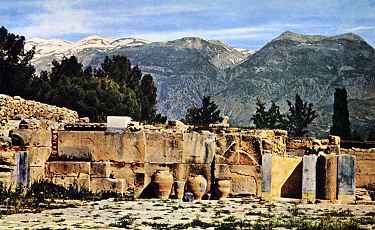
Tutorial No.5. - Image 027
Looking northwards across the ruins of Phaestos in southern Crete. Beyond in the distance we can see Mount Ida, the highest point on Crete.

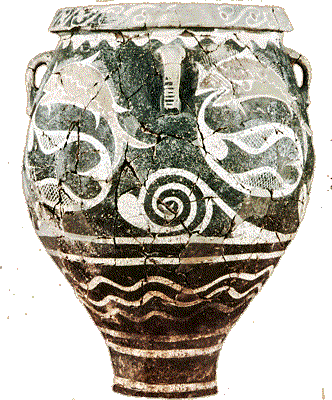
Tutorial No.5. - Image 028
This Old Palace pithos in the Kamáres style is from Phaistos and 50cm. high. The decorative and rhythmic design in three colours shows fish being caught in a net.

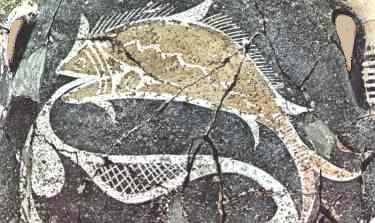
Tutorial No.5. - Image 029
Detail: Shows fish being caught in a net.

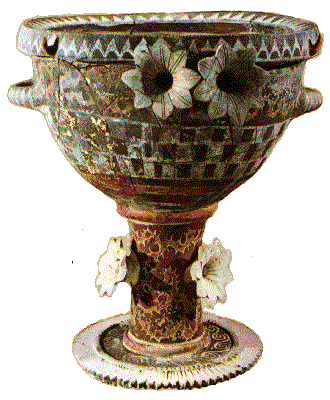
Tutorial No.5. - Image 030
Large goblet or stemmed bowl with sculptural flowers stuck on. Typical of the later Kamáres dark on light style decoration. The brightly coloured design painted on is still striking even though worn. May imitate a much smaller gold goblet.

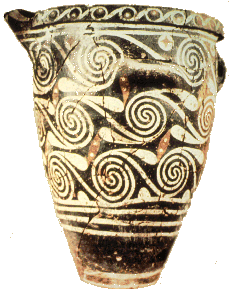
Tutorial No.5. - Image 031
A large Kamáres ware jug ht.69cm. From the Old palace at Phaistos 19th century BC. Painted in red and white slip on a black/brown background.

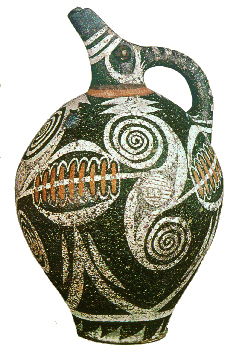
Tutorial No.5. - Image 032
Beak-spouted Kamáres ware pot. From the first palace at Phaistos. Approx. 1800BC ht.27 cm.

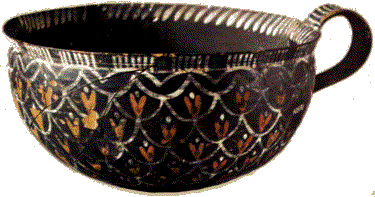
Tutorial No.5. - Image 033
Cup. Kamáres ware.From the First Palace at Phaistos. Approx. 1800BC. dm.12cm. This comes from the same stylistic phase as the jug above. It is an example of 'egg shell' ware indicating the refinement of this thin-walled and decorated cup.

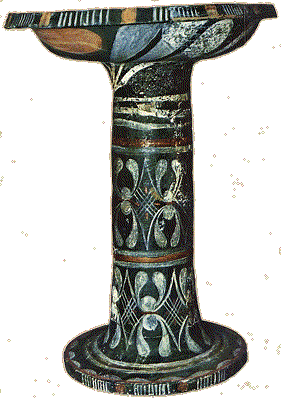
Tutorial No.5. - Image 034
A graceful high-stemmed Kamáres vase or dish decorated in the beautiful light on dark style. Made about 1700BC.

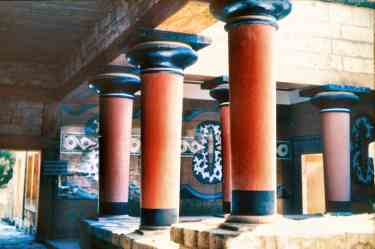
Tutorial No.5. - Image 035
Because of the painstaking reconstruction of a few of the palaces like this one at Knossos we do have a picture of comfort and elegance.

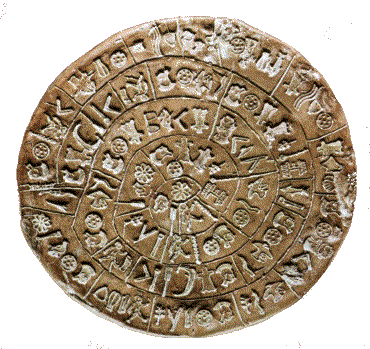
Tutorial No.5. - Image 036
Scratched on this small clay disk is an example of their early script called Linear A. The stamps form an outward spiral of symbols, perhaps a list of some sort. A pictographic script like the Egyptian Hieroglyphs or Chinese writing.

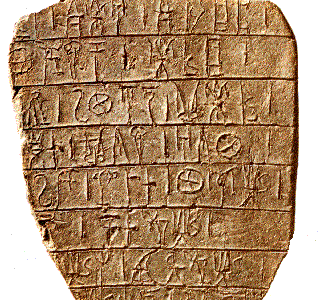
Tutorial No.5. - Image 037
A later script, called Linear B. It appears to be a form of primitive Greek and was translated only in 1952.

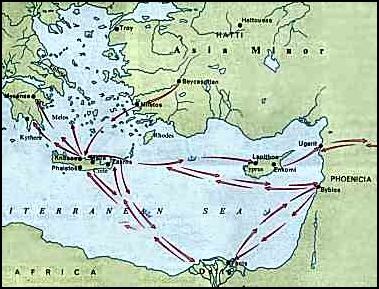
Click for
Tutorial No.5. - Image 038
Minoan Trade Routes .

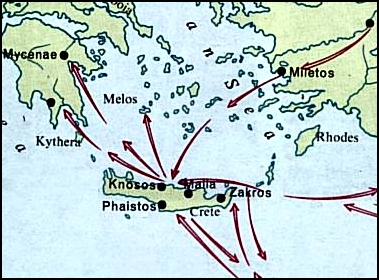
Click for
Tutorial No.5. - Image 038a
Minoan Trade Routes - Detail 1.

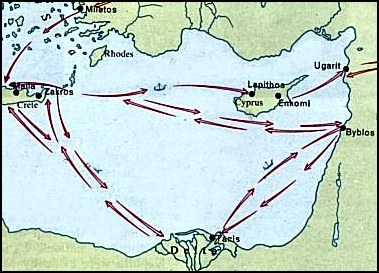
Return to
Tutorial No.5. - Image 038b
Minoan Trade Routes - Detail 2.

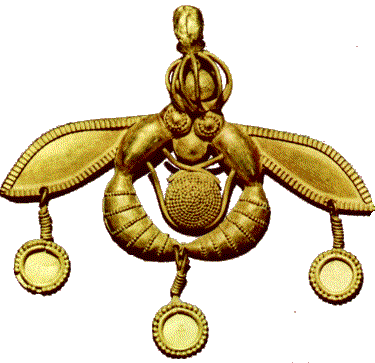
Tutorial No.5. - Image 039
A gold pendant showing two bees and a honey-comb. Embossed work with granulation. From a tomb near Malia. Crete. 1900-1700BC

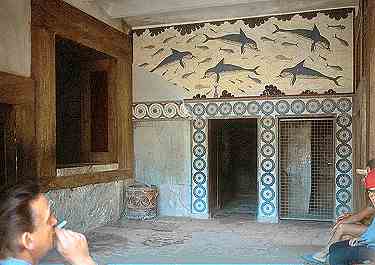
Tutorial No.5. - Image 040
This frieze of dolphins in the Cretan palace of Knossos decorates apartments of a lady who was perhaps the queen. Nowhere else in the art of the ancient world is there such a lightness of spirit.

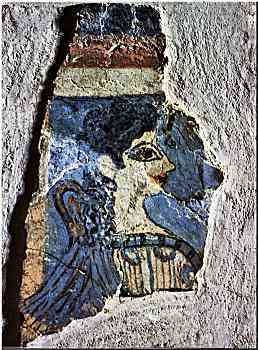
Tutorial No.5. - Image 041
This fragment of a fresco from the Palace at Knossos is about 12 inches high. ca.16th century BC. The blue colour materials used were based on Kyanos, the soda/copper frit paste.

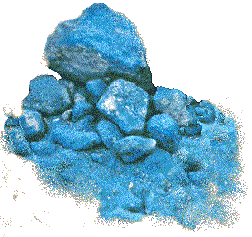
Tutorial No.5. - Image 042
A pile of powdered kyanos found in a Minoan/Mycenaean site in Greece.

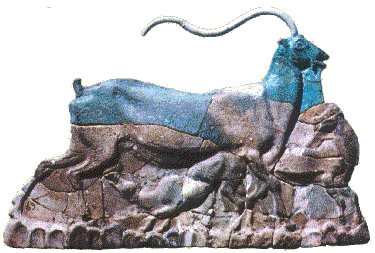
Tutorial No.5. - Image 043
Plaque press-moulded in blue frit. An example of the many decorative objects which were inlaid into furniture or boxes. Found in Knossos

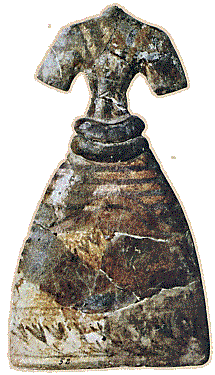
Tutorial No.5. - Image 044
Votive statuette in polychrome quartz frit paste(faience!)

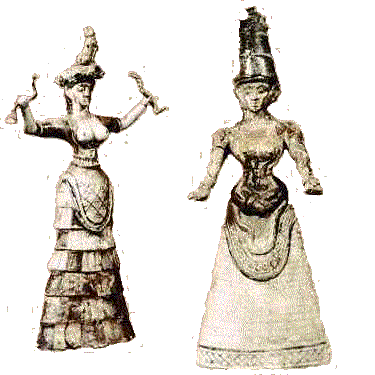
Tutorial No.5. - Image 045
Two polychrome frit paste figurines late 16th century BC. Found at Knossos.

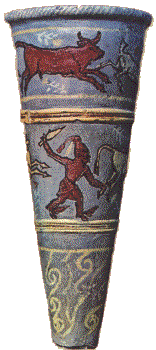
Tutorial No.5. - Image 046
A Cretan style fritware decorated rhyton. It was found at Kition in Cyprus and dated to the 13th century BC.

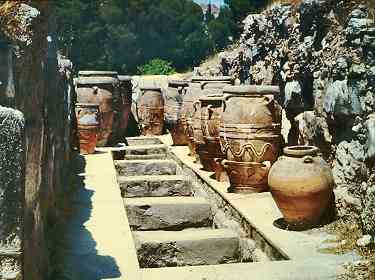
Tutorial No.5. - Image 047
Part of an underground storage chamber in the palace of Knossos. It dates from about 1600BC.

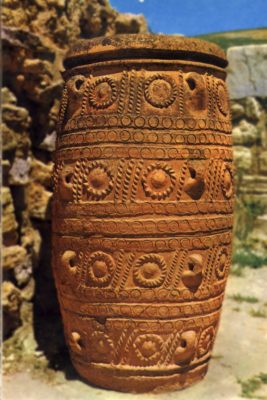
Tutorial No.5. - Image 048
One of two ancient Cretan storage jars. These stand about four feet high, but examples six feet high have been found.

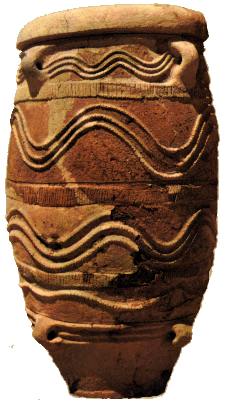
Tutorial No.5. - Image 049
One of two ancient Cretan storage jars. These stand about four feet high, but examples six feet high have been found.

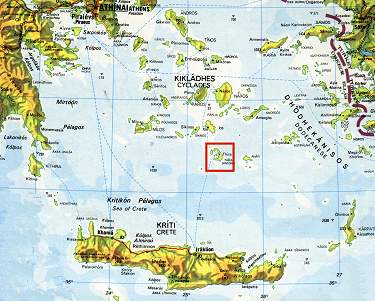
Click for detail of
Tutorial No.5. - Image 050a
Map of the Aegean - Thera island at the centre

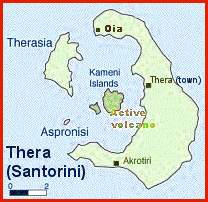
Back to Map
Tutorial No.5. - Image 050b
Detail of Thera island today

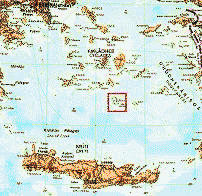
Tutorial No.5. - Image 050c
The Island of Thera - Before and After the Explosion of 1628BC.

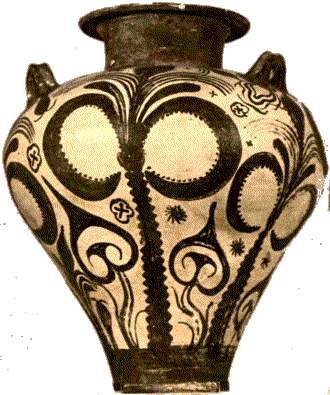
Tutorial No.5. - Image 051
The bold rhythmical movements shown here are a common characteristic of the period when Crete was at the height of its power, early 15th century BC.

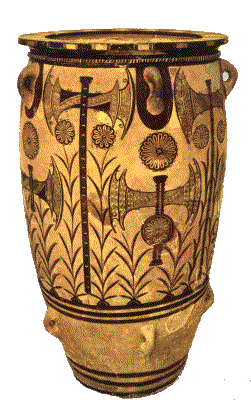
Tutorial No.5. - Image 052
This large storage jar is unusual in that instead of paintings of sea plants and animals this decoration appears to be regal or religious symbols importance to the Cretans: a double headed axe and a rosette pattern.

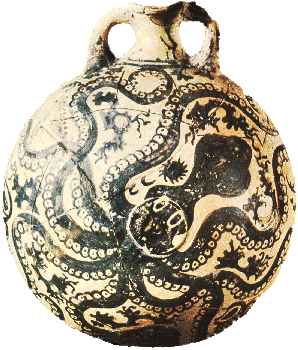
Tutorial No.5. - Image 053
Pilgrim flask or stirrup jar. Made out of two similar leather-hard bowls, to produce the globe-like shape. Octopus tentacles grasp the globular shape convincingly, emphasising the rounded form. Dated to the close of the 16th cent.BC.ht.28cm.

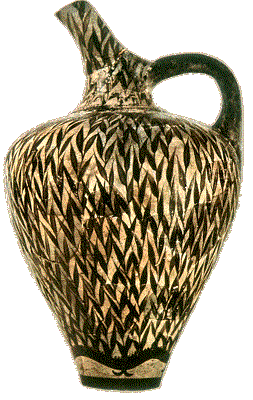
Tutorial No.5. - Image 054
A late 16th century BC jug made in a bird-like form reminscent of the Kamáres style. The design is based on leafy stems which follow the upward thrust of the form in gentle undulating patterns.

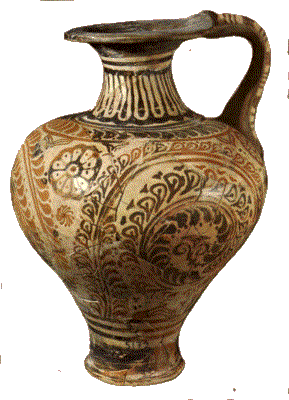
Tutorial No.5. - Image 055
A large decorated vase made during the first third of the 15th century BC. The plant-like decoration consists of a triple repetition of a long spiral-like coiled leafy flower stem ending in a flower at the centre of the spiral.

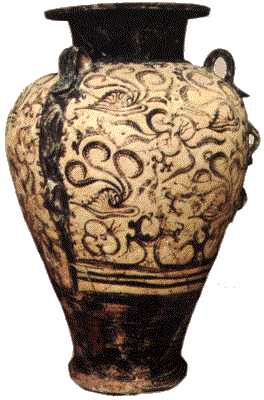
Tutorial No.5. - Image 056
A large amphora with three handles. The decoration is in the popular Marine Style. Although this example was found in a tomb on the mainland of Greece, it was decorated by a Cretan painter. It is dated to the first third of the 15th century BC.

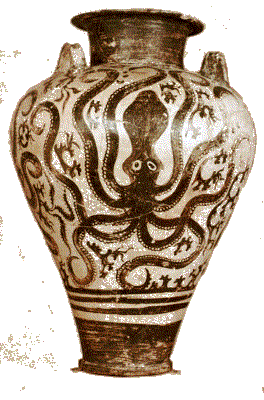
Tutorial No.5. - Image 057
A similar amphora to the last one. Another very popular design. Three octapuses straddle this pot. Painted in the brown-black vitreous slip on the pale terracotta body. From the first half of the 15th century BC.

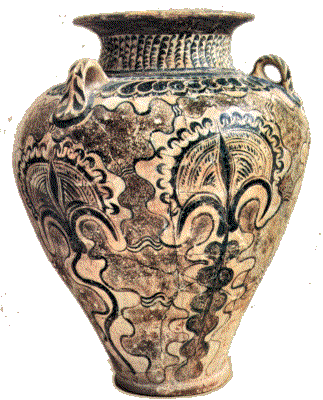
Tutorial No.5. - Image 058
This large Amphora with three handles comes from the palace of Knossos. The style is typical of the mid to late 15th century BC. The six papyrus reeds which dominate the decoration suggest Egyptian influence.

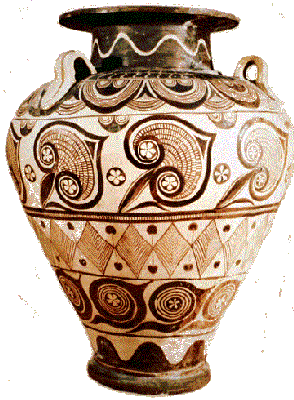
Tutorial No.5. - Image 059
The shape of of this large storage jar ca.1400BC. is traditional but the naturalistic Marine style has been replaced by a more rigid formality of horizontal bands containing abstract symbols or linear patterns. The Mycenaean Greeks are now in full control.

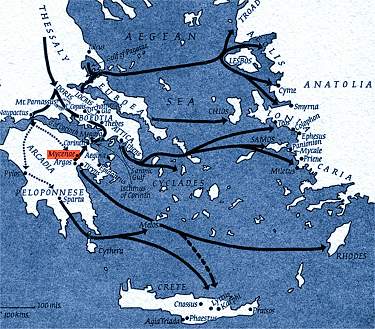
Achaean Greek Fortress -
Tutorial No.5. - Image 060
The Greek Migrations into the Aegean

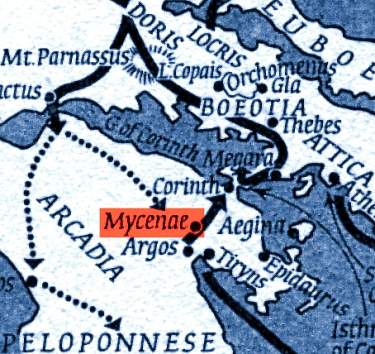
Map of the
Tutorial No.5. - Image 060a
Detail - The Achaean Greek Fortress, Mycenae. A view from the southwest.

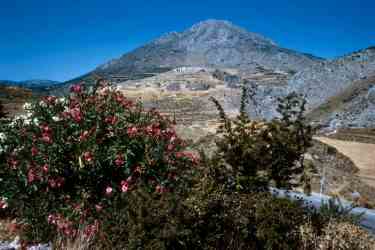
Tutorial No.5. - Image 061
Mycenae, the Achaean Greek fortress stronghold in Southern Greece.

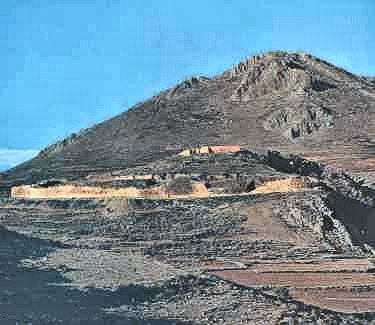
Tutorial No.5. - Image 062
Another view showing the walls. The great Lion Gateway is at the far left corner. The citadel and palace was high up in the centre, the walled structure.

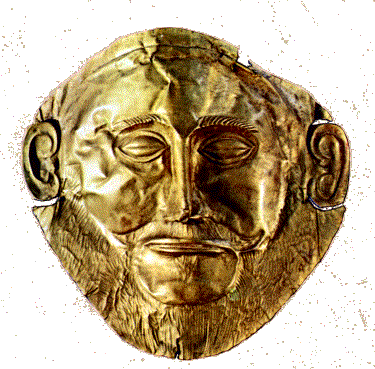
Tutorial No.5. - Image 063
One of the curiously shaped gold masks found in the royal grave circles at Mycenae. It belonged to a Mycenaean warrior in the 16th century BC and does suggest the viking-like qualities of these early Greeks.

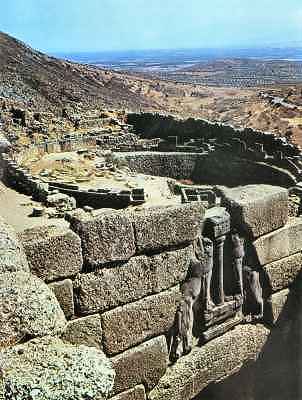
Tutorial No.5. - Image 064
Just in front of the Lion Gateway, inside the walls, are the circular shaft royal graves where Schleimann found the Gold Masks and other 16th BC century treasures. From this hilly position the rulers of Mycenae could look down upon and control the fertile plain of Argos to the Aegean Sea.

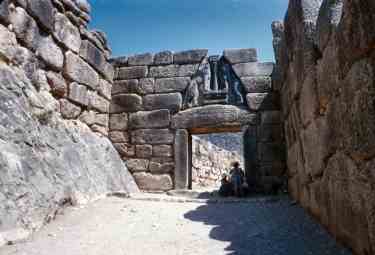
Tutorial No.5. - Image 065
The Massive stone walls and the famous gateway with the carving of two lions either side of a column. Their meaning is unknown, but the enormous blocks of stone suggest an impregnable stronghold, which it proved to be for many centuries.

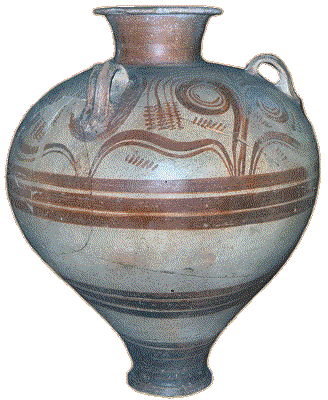
Tutorial No.5. - Image 066
A globular pot made about 1350BC. The basic pot-making craftsmanship is excellent, but the decoration has now deteriorated into meandering curved strokes.

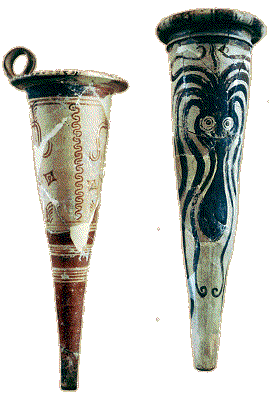
Tutorial No.5. - Image 067
A example of the decay of ceramic decoration during Mycenaean Age. Here is a popular Minoan image now squashed thoughlessly onto an inappropriate shape.


Tutorial No.5. - Image 068
Two 16th century BC Minoan figurines, refined and delicate, complex technically and made in multicoloured frit paste.

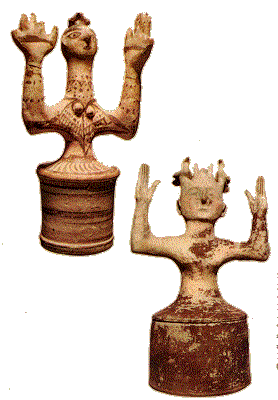
Tutorial No.5. - Image 069
Two examples of Mycenaean clay figurines of their goddess from about 14th century BC. By comparison with the previous figurines they are crude and ugly.

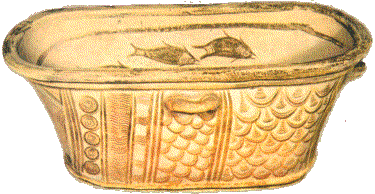
Tutorial No.5. - Image 070
A clay bath-tub made about 1350BC. It is interesting to see that quite large objects are still being mase and fired. The decoration consists of traditional motifs which were often repeatedly copied. Although primarily for domestic use, baths were often used for burial in Crete and on the Mainland.

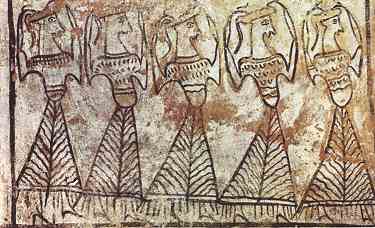
Tutorial No.5. - Image 071
These figures are painted on a clay coffin found in the cemetery of Tanagra in the late 14th century BC. A stiff naive figure style has developed. A procession of lamenting women with their hands raised to their heads. They are dressed in traditional Minoan fashion. Probably cruder copies of earlier coffin paintings.

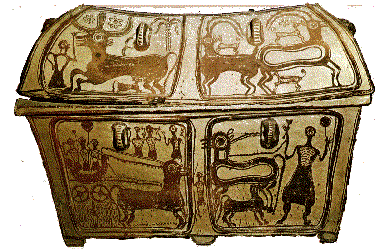
Tutorial No.5. - Image 072
Another decorated coffin from the 13th century BC. There is no reference to the Minoan past here. The sophisticated painting and drawing traditions are gone.The naive drawing of all these objects and creatures is now worlds away from the sophisticated imagery of the Palace Periods.

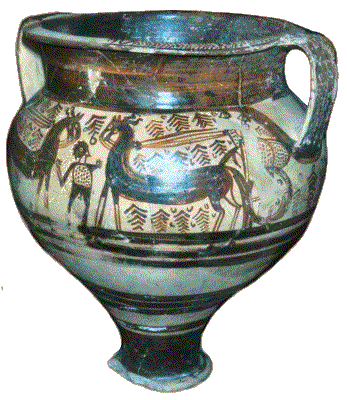
Tutorial No.5. - Image 073
A large Mycenaean Krater ca.1400-1300BC.What is extraordinary about this period is the quality of the pot itself. This is the work of a craftsman. The art of drawing and decoration had been lost but the technique of pottery making and firing remains so high.

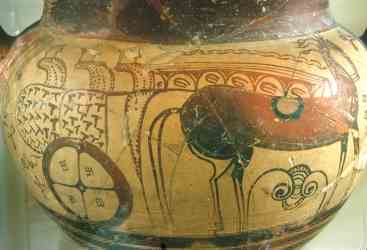
Tutorial No.5. - Image 074
A detail from an amphora of the 13th century BC. the men, horses and chariots portrayed are portrayed in an extremely stylised manner, but the thrown and turned pot, and the firing too, is a work of excellent potter-craftsman.

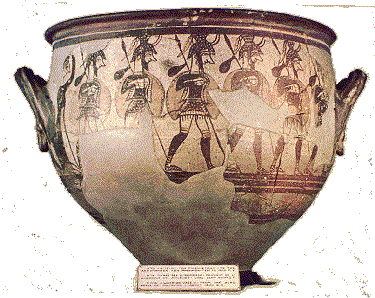
Tutorial No.5. - Image 075
A large bowl from the mainland in the 12th century BC. The decoration, not the shape communicates the great change in spirit between the Minoan and the late Mycenaean world. The rhythms of plant and animal life are gone, instead are stiff and stylised drawings of chariots, horses and armed men bristling with helmets, spears and daggers.

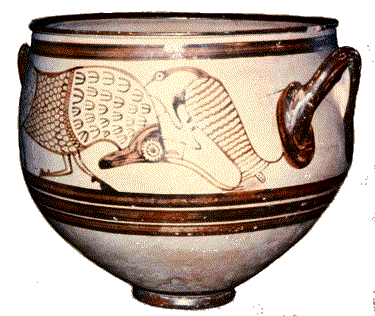
Tutorial No.5. - Image 076
In some areas and in some pots there remains the sparkle of sensitive talent for decoration as well as excellent potting. This is an example. It is perhaps a glimpse of the recovery to come.

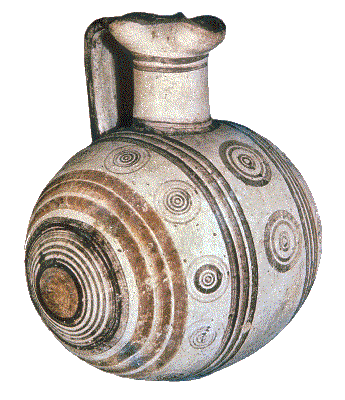
Tutorial No.5. - Image 077
This small liquor barrel flask shows the essential qualities which remain at the end of the Mycenaean period. All the colour and creativity of the Minoans has gone. However, a sound foundation of pottery craftmanship still remains to be exploited by a new culture.
This is the last illustration.
I hope you have found tutorial No.5 interesting and perhaps useful.
Tutorial No.6 is about Classical Greece: the ceramics produced by the later Greeks in their City States and Colonies.

That was the last illustration in this tutorial

Last checked, revised or updated 17th July 2004
©2001 Victor Bryant
To Index Home Page